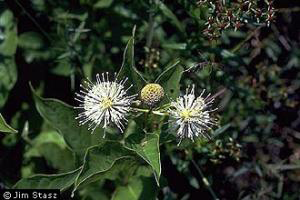Cephalanthus occidentalis
Common buttonbush is the only wetland shrub that has whorled leaves and spherical-shaped flowers.
Photo Credit: © Jim Stasz, USDA-NRCS PLANTS Database.
Cephalanthus occidentalis
Common Name: common buttonbush
Other Common Names: buttonbush
Plant Functional Group: Deciduous broadleaf
Class > Order > Family: Magnoliopsida > Gentianales > Rubiaceae
